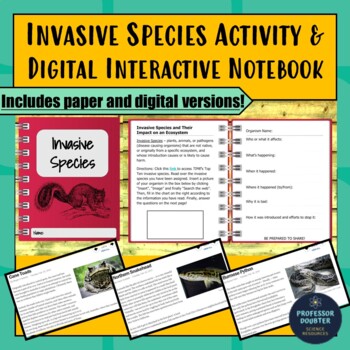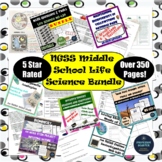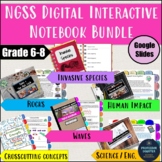Invasive Species Activity Reading and Questions NGSS MS-LS2-4 Distance Learning
- Word Document File
- Google Apps™

What educators are saying
Also included in
- This NGSS Next Generation Science Standards for Middle School Science Mega Bundle has ALL of my NGSS labs, lessons, bulletin boards, posters, activities, assessments, projects, and other resources combined into one product (most of which have been or are being edited for distance learning) ! It offePrice $349.99Original Price $521.25Save $171.26
- This NGSS Next Generation Science Standards for Middle School Science is a life science bundle of all of my NGSS aligned life science worksheets, labs, activities, assessments and other resources combined into one product! These activities are sure to fit perfectly into your biology and/or ecology uPrice $90.00Original Price $119.50Save $29.50
- NEW! This slow GROWING bundle contains 6 of my NGSS aligned digital interactive notebooks in Google Slides for middle school which include Human Impact, Rocks and the Rock Cycle, Crosscutting Concepts, Science and Engineering Practices, an Invasive Species activity, and a Waves Stations investigatioPrice $26.00Original Price $32.00Save $6.00
Description
Newly updated with a DIGITAL INTERACTIVE NOTEBOOK in Google Slides, this invasive species lesson plan with worksheets is great for in person or distance or home learning! This cross-curricular lesson can be used as a LOW PREP SUB PLAN in an ecosystems unit, to promote literacy in science class, for introducing invasive species, or for gathering evidence for the NGSS Performance Expectation MS-LS2-4. Construct an argument supported by empirical evidence that changes to physical or biological components of an ecosystem affect populations. It even makes for a perfect introduction or reinforcement of what evidence actually is (see homework assignment in conclusions)! It is completely EDITABLE so you can change it to fit the needs of your students and unit! Also aligned with the Common Core!
Check out other science resources in my store here!
Lesson Overview: Students…
- can choose one of the provided 10 invasive species, can be assigned one invasive species, or be split into 10 groups (there are 10 examples so you can omit some or double them up within groups)
- learn what an invasive species is
- read about an invasive species on a card (link provided to read/print information)
- write the who, what, when, where, why, and how in a chart
- share with the class or submit answers electronically
- complete conclusion questions in reference to invasive species and their impact on populations
- search for evidence online for homework to share the next day
Invasive species list includes gray squirrels, Asian carp, zebra mussels, cane toad, rabbits, kudzu plant, killer bees, starling, northern snake head, and Burmese python!
Resource includes:
- Student worksheet with graphic organizer
- Link to invasive species reading
- Conclusions questions and homework
- Link to the Digital Interactive Notebook (Google Slides)
Looking for assessments for individual Life Science MS-LS2 standards?
MS-LS2-1 Effects of Resource Availability
MS-LS2-2 Patterns of Interactions
MS-LS2-3 Cycling of Matter and Energy
MS-LS2-4 Changes Affect Populations
MS-LS2-5 Maintaining Biodiversity
Want ALL of the MS-LS2 Ecosystems: Interactions, Energy, and Dynamics Assessments Questions at a discounted price? MS-LS2 All Assessments and Task Questions
Looking for assessment resources for more NGSS standards? Check out my other Assessments here: NGSS Assessments and Test Questions
Let’s Connect!
Follow my store at this link to stay up-to-date on my latest NGSS resources! Click here!
Are you on Facebook? Be sure to follow me on Facebook for NGSS FREEBIES, updates on what I’m working on, and of course, science memes! Professor Doubter's Facebook Page
Interested in other Life Science products?
Adaptations Matching Worksheet
Adaptations and Biomimicry Stem Lab
Maintaining Biodiversity Activity
Modeling Food Chains and Food Webs Affected by the BP Oil Spill
Living Things are Made of Cells Online Investigation
Modeling Cell Organelles with Analogies
Bundle of the Previous Two Cells Resources
Natural Selection Butterfly Lab
Resource Availability in Ecosystems Activity
Gathering Evidence for Photosynthesis Lab
NGSS Unit Template for Lesson Planning with EXAMPLE
Looking for other NGSS lessons, units, activities, etc.? Check out my store for more here: Store Link.
Buy the bundle to have access to all NGSS resources!
NGSS Physical Science Bundle: Click Here
NGSS Life Science Bundle: Click Here
NGSS Earth Science Bundle: Click Here
NGSS All Resources Bundle: Click Here
Feel free to share my website with colleagues. Each purchase is a license for ONE person to use in a classroom setting per my Terms of Use. Distribution or sharing of any products are in violation of copyright law.
If you like it, rate me! If you love it, follow me! Be sure to check out my store for other NGSS aligned activities!








